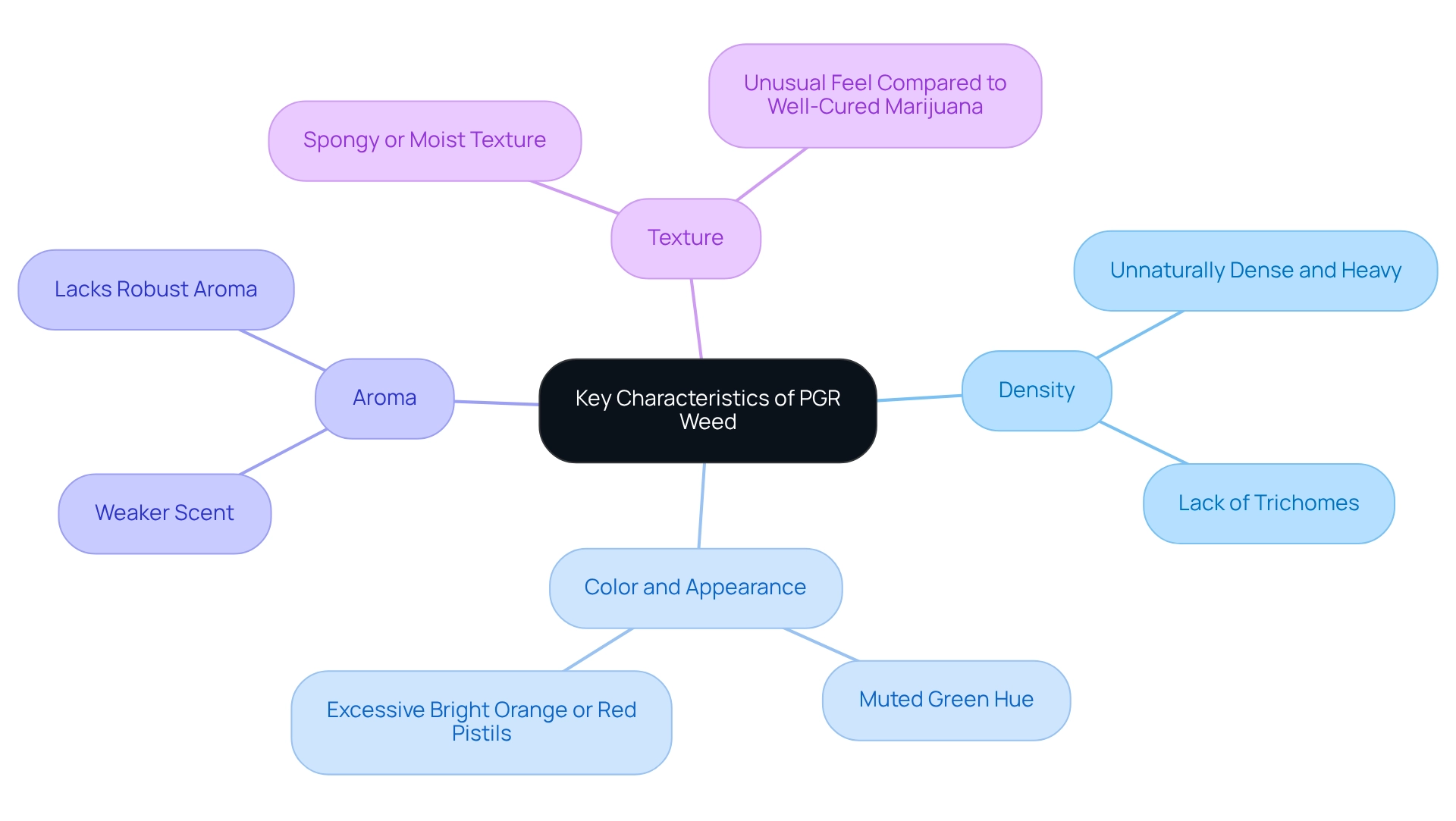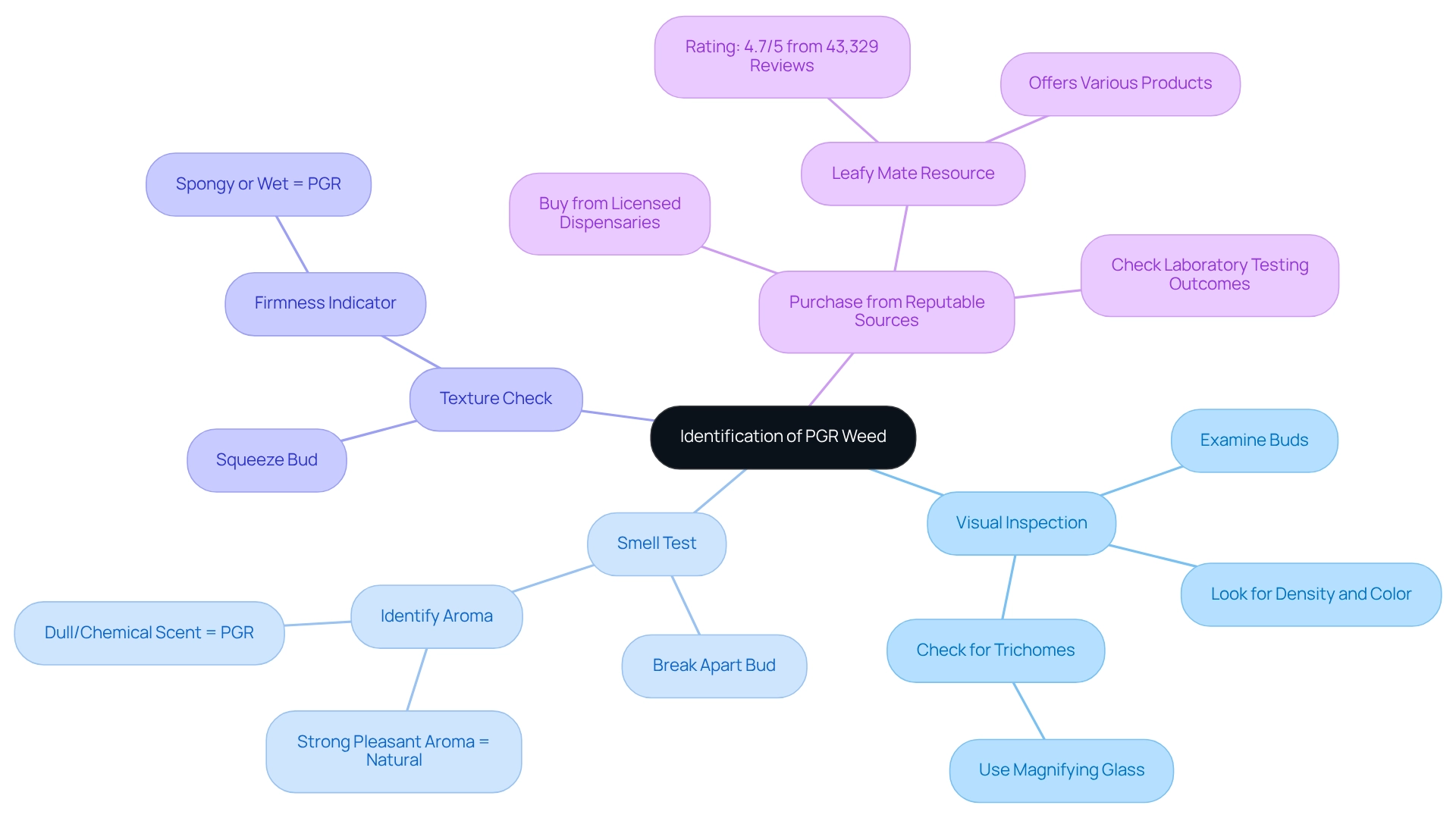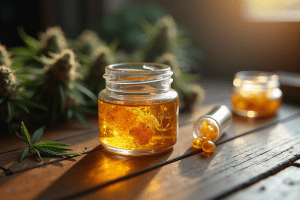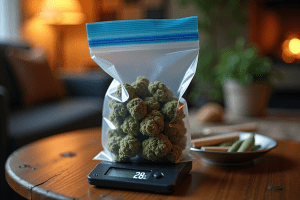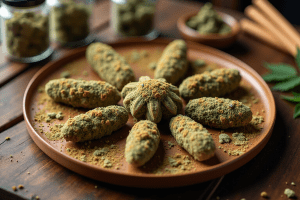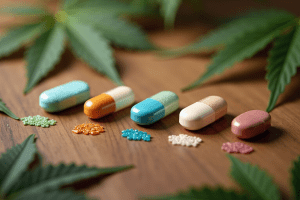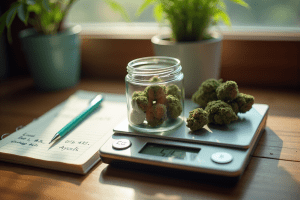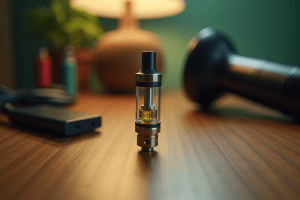Overview
In our journey towards safer cannabis consumption, it’s essential to understand how to identify PGR (Plant Growth Regulator) weed. Here are four vital steps that can help us make informed choices:
- Visual inspection
- Smell tests
- Texture checks
- Purchasing from reputable sources
These steps are not just practical; they are crucial for distinguishing between potentially harmful PGR-treated cannabis and naturally grown alternatives. By being aware of these differences, we can promote safer consumption practices together.
Have you ever wondered about the health risks associated with synthetic growth regulators? By raising awareness, we can empower ourselves and others to make healthier decisions. Let’s take these steps to ensure we are consuming cannabis that aligns with our values and well-being.
Introduction
In the intricate world of cannabis cultivation, the use of Plant Growth Regulators (PGRs) has ignited important discussions among consumers and industry experts. While these synthetic chemicals can enhance the visual appeal and yield of cannabis, they also bring forth serious health concerns that we all should be aware of. As the market continues to grow, understanding the implications of PGR-treated cannabis becomes essential for making informed choices together.
This article explores the definition and significance of PGR weed, the key characteristics that distinguish it from naturally grown options, and practical tools and techniques for identification. By addressing common misconceptions and challenges, we can empower ourselves with knowledge, ensuring safer and healthier cannabis consumption practices. Have you ever wondered how PGRs might affect your choices? Let’s navigate this journey together.
Understand PGR Weed: Definition and Importance
PGR weed is marijuana that is cultivated with the use of Plant Growth Regulators (PGRs), which are synthetic chemicals designed to manipulate the growth of plants. While these substances can enhance yield and improve the visual appeal of marijuana, they also raise significant health concerns. For buyers, understanding PGR weed is essential to avoid potentially hazardous products and to distinguish between naturally cultivated plants and those treated with these substances.
The use of plant growth regulators can lead to denser buds and altered growth patterns, which may leave buyers uncertain about the quality and safety of the cannabis they choose. Research shows that certain PGRs, such as chlormequat chloride, daminozide, and Paclobutrazol, can negatively impact the flavor and aroma of the final product, making it less appealing. Additionally, these artificial hormones have been linked to health risks, prompting a growing awareness among consumers about the importance of seeking natural alternatives.
A recent case study highlights the impact of synthetic hormones on marijuana quality, revealing that the use of PGRs can result in products that not only compromise flavor but also pose health risks to users. This underscores the necessity for marijuana users to be informed about the growing methods associated with the products they select. As science writer Alexander Beadle noted, “It’s clear that there needs to be improved access to reliable and accurate information surrounding safe chemical usage and growth practices.”
At Leafy Mate, we play a vital role in providing patient education and resources through our blog and FAQ sections, helping new marijuana users navigate the complexities of PGR weed. By connecting users with trustworthy medical marijuana physicians and quality marijuana brands, Leafy Mate ensures that individuals have access to the best information available in the marijuana sector. Local dispensaries, like one on South Cedar St in Lansing, serve as hubs for marijuana education and premium products, offering individuals reliable information about cultivation practices.
As the marijuana sector evolves, staying informed about PGR weed and its implications is crucial. By understanding the differences between PGR weed and naturally grown alternatives, consumers can make more informed choices, ultimately fostering safer and healthier consumption practices. We invite you to explore Leafy Mate’s extensive directory of local dispensaries to find reliable sources and enhance your experience together.
Identify Key Characteristics of PGR Weed
To effectively identify PGR (Plant Growth Regulator) weed, let’s consider some key characteristics together:
-
Density: PGR buds often feel unnaturally dense and heavy, with a rock-hard texture that sharply contrasts the airy feel of natural cannabis. Have you ever noticed how different they can be? A significant indicator of PGR weed is the noticeable lack of trichomes—those tiny, crystal-like structures that produce cannabinoids and terpenes, which are often missing in PGR weed. Natural marijuana typically showcases a rich coating of these trichomes, enhancing its potency and aroma. It’s essential to recognize this difference.
-
Color and Appearance: PGR marijuana often presents a muted green hue, accompanied by an excessive amount of bright orange or red pistils. This color imbalance can indicate artificial growth enhancement. Have you seen this before?
-
Aroma: The scent of PGR weed tends to be weaker, lacking the robust, fragrant aroma that high-quality marijuana is known for. A reduced scent can suggest deteriorated quality, which is something we should all be aware of.
-
Texture: When handling PGR marijuana, you may observe a spongy or moist texture, which is unusual for well-cured marijuana. This unusual feel can be a warning sign for consumers like us.
Understanding these characteristics not only aids in making informed choices but also encourages responsible cultivation practices within our community, ensuring product safety and quality. As studies indicate, substances like paclobutrazol can negatively impact male fertility and cause liver damage, highlighting the importance of being cautious with PGR weed. By taking the necessary precautions and staying informed, we can minimize our risk of consuming PGR weed and enjoy the benefits of the plant without compromising our health. Identifying the distinctions between PGR weed and non-PGR weed is essential for us as consumers, as it promotes a safer and more responsible market for the herb we care about.
Utilize Tools and Techniques for Identification
To effectively identify PGR weed, let’s explore some helpful tools and techniques together:
- Visual Inspection: Take a moment to closely examine the buds. Look for density, color, and the presence of trichomes. Using a magnifying glass can enhance your view of the trichomes, which are crucial indicators of quality.
- Smell Test: Gently break apart a bud and take a whiff. Natural marijuana typically emits a strong, pleasant aroma, while PGR weed may emit a dull or chemical-like scent, indicating potential issues.
- Texture Check: Squeeze the bud lightly; it should feel firm yet not overly hard. If it feels spongy or excessively wet, this may indicate the use of PGR weed treatment.
- Purchase from Reputable Sources: Always buy marijuana from licensed dispensaries that provide detailed product information. Look for laboratory testing outcomes that verify the absence of harmful plant growth regulators. Some synthetic growth substances have been linked to serious health issues, leading to calls for stricter regulations. Leafy Mate, rated 4.7 out of 5 from 43,329 reviews, is a reliable resource for finding reputable dispensaries and offers a variety of products, including flower, edibles, concentrates, topicals, and more.
As we move forward into 2025, the regulation of plant growth regulators continues to evolve, reflecting diverse public health priorities and agricultural needs across countries. A case study titled “Health Risks Associated with PGRs” highlights the potential health risks posed by synthetic PGRs, emphasizing the importance of avoiding PGR-treated marijuana. By staying informed and applying these methods, we can collectively reduce the risk of consuming PGR weed and enjoy the advantages of the plant without jeopardizing our health. As an expert noted, by taking the necessary precautions and staying informed, you can minimize your risk of consuming PGR weed and enjoy the benefits of PGR weed without compromising your health.
Navigate Misconceptions and Challenges in Identification
Navigating misunderstandings about pgr weed can indeed be challenging, but at Leafy Mate, we are here to support new marijuana consumers in making informed choices. Let’s take a moment to address some common myths and the truths that lie behind them:
- Myth: All cannabis that looks good is safe.
Truth: Just because marijuana is visually appealing does not guarantee it is free from harmful plant growth substances. It’s essential to look beyond mere appearance and conduct thorough research from reliable sources. At Leafy Mate, we connect you with trusted cannabis brands and medical marijuana doctors who prioritize quality and safety. - Myth: Plant growth regulators are harmless.
Truth: Many synthetic plant growth regulators pose significant health risks, including potential carcinogenic effects. In fact, the use of pgr weed is raising serious concerns, as most PGRs are banned or classified as pesticides in Europe and the UK. Understanding these dangers is vital for making informed decisions regarding marijuana use, and Leafy Mate offers educational resources to help you comprehend these risks. - Myth: You can’t tell the difference between PGR and natural marijuana.
Truth: With the right knowledge and tools, buyers can learn to identify key traits that distinguish PGR weed from premium marijuana. Education on this topic is crucial, especially as the marijuana market increasingly focuses on quality and safety. Leafy Mate is dedicated to empowering individuals with the information they need to navigate the marijuana landscape effectively.
By grasping these misunderstandings, we can all navigate the marijuana market more effectively, encouraging safer choices and building a community of knowledgeable users. As Simpa Carter wisely stated, “Using potentially dangerous chemicals just to make money while harming your fellow man is low.” As the industry evolves, staying informed about the risks associated with pgr weed will be essential for all marijuana users. Leafy Mate is committed to providing the resources and support necessary for new cannabis consumers to make safe and informed choices together.
Conclusion
The exploration of PGR weed offers vital insights into the implications of using Plant Growth Regulators in cannabis cultivation. Understanding what PGR weed is and its potential health risks is essential for consumers who wish to make informed choices. The density, appearance, aroma, and texture of cannabis can vary significantly between PGR-treated and naturally grown options. This highlights the importance of being able to identify these characteristics.
By utilizing practical tools and techniques—such as visual inspection, smell tests, and purchasing from reputable sources—consumers can navigate the cannabis market more effectively and minimize the risks associated with PGR weed. Misconceptions surrounding the safety and quality of cannabis products further underscore the need for education and awareness. Knowledge empowers us to seek out safer, high-quality cannabis while avoiding products that may compromise our health.
As the cannabis industry continues to evolve, staying informed about PGRs and their implications is paramount. By prioritizing education and responsible consumption practices, we can contribute to a healthier and safer cannabis community. Engaging with reliable resources, like Leafy Mate, not only enhances our personal choices but also fosters a culture of accountability and transparency within the cannabis market. Together, let’s make informed decisions for a brighter future in cannabis.
Frequently Asked Questions
What is PGR weed?
PGR weed is marijuana that is cultivated using Plant Growth Regulators (PGRs), which are synthetic chemicals designed to manipulate plant growth.
What are the benefits of using PGRs in marijuana cultivation?
The use of PGRs can enhance yield and improve the visual appeal of marijuana, leading to denser buds and altered growth patterns.
What are the health concerns associated with PGR weed?
Certain PGRs have been linked to health risks and can negatively impact the flavor and aroma of marijuana, making it less appealing and potentially hazardous for consumers.
Can you name some specific PGRs that are used in marijuana cultivation?
Some specific PGRs include chlormequat chloride, daminozide, and Paclobutrazol.
Why is it important for buyers to understand PGR weed?
Understanding PGR weed is essential for buyers to avoid potentially hazardous products and to distinguish between naturally cultivated plants and those treated with synthetic substances.
How does PGR weed affect the quality of marijuana?
The use of PGRs can compromise the flavor and aroma of marijuana, resulting in a product that may be less enjoyable for consumers.
What role does Leafy Mate play in educating consumers about PGR weed?
Leafy Mate provides patient education and resources through their blog and FAQ sections, helping new marijuana users navigate the complexities of PGR weed and connect with trustworthy medical marijuana physicians and quality brands.
How can consumers find reliable information about marijuana cultivation practices?
Local dispensaries, such as those in Lansing, serve as hubs for marijuana education and premium products, offering reliable information about cultivation practices.
Why is it crucial to stay informed about PGR weed as the marijuana sector evolves?
Staying informed about PGR weed and its implications allows consumers to make more informed choices, fostering safer and healthier consumption practices.
Get Your Medical Card
Connect with a licensed physician online in minutes


